While redcurrant and gooseberry might be known as ‘heirloom fruits’ and not receive their fair share of attention, this isn’t the case at BelOrta. “We carry the entire range of soft fruit, and we also have good sales for redcurrant and gooseberry, and we can create a decent income for our growers,” says Miguel Demaeght, Division Head Sales Fruit for BelOrta. The cooperative auction doesn’t just focus on the three traditional soft fruits – strawberry, raspberry and blackberry – but also continues to be dedicated to innovation regarding redcurrant and gooseberry. Annually, around 350 tonnes of redcurrants of the Rovada and Haronia varieties are marketed. “Haronia is a little earlier than Rovada, and has a good and even blush, which other early varieties often don’t have.”
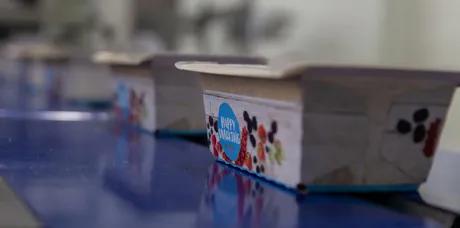 Happy snacking concept in cardboard punnets with top seal
Happy snacking concept in cardboard punnets with top seal
The redcurrant season started in May with the harvest of berries grown in greenhouses. Larger volumes are expected from early June. These are the redcurrants mostly grown outdoors under rain covers. This cover ensures protection from rain and direct sunlight, and keeps the vines of berries dry, so that moulds can’t grow in the packaging due to the harvesting of wet berries.
Redcurrants, blackberries, strawberries and raspberries of BelOrta growers are grown under cover. “The investment in soft fruit is too considerable to grow unprotected,” Miguel says. Redcurrant is also stored in ULO (Ultra Low Oxygen) cold stores, and marketed until Christmas. The cold store in Borgloon offers the option to store redcurrant at pallet level, and to adjust CO2 and oxygen for each individual pallet. Miguel says prices for redcurrant are currently at a correct level, but that these are still too high for consumers. The redcurrants now mostly find their way to specialist shops. Later in the season, Belgian retail will be supplied as well, and a part will be exported.
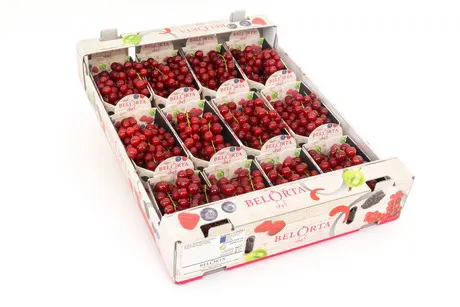
Good sales for redcurrant and gooseberry at BelOrta
Shelf life
Gooseberries are harvested from May to July. Thanks to ULO storage, the season is extended until the third week of August. Around 80 tonnes of gooseberries find their way to Belgian consumers, mostly via the retail channels, but also via specialist shops. One trend in gooseberries is supplying ready-to-eat gooseberries. Miguel says that although gooseberries were harvested unripened in the past, they are now picked green with a red blush on buyers’ demand. As a result, the fruit is sweeter.
In raspberries, Miguel has noticed a clear rise in volume. Just as with strawberries and blackberries, raspberries have about half their volume exported. That means shelf life is an important factor, and that’s the reason that in 95 per cent of all cases, the Kwanza variety has been chosen. Miguel explains that this variety offers a good shelf life, but that it also scores high regarding colour and flavour, and is able to withstand transport well. The soft fruit, which isn’t just sold in Belgium but is exported as well, has a different pricing. Although Belgian retail prefers Belgian product on their shelves, origin is less important on the wider European market, and pricing is more European-guided, according to Miguel. BelOrta is dedicated to innovations regarding production techniques and varieties, and that’s how they continue to try to get the best prices from the market.
Changing prices
The strawberries are experiencing a different start of the season. Because there were few warmer periods, and nights are still relatively cold as well, the volumes of production on benches and the outdoor strawberries are falling behind compared to previous years. Miguel has noticed that pricing in strawberries is very changeable, with sporadic recoveries. BelOrta works a lot with the Malling Centenary variety. “This variety might be a bit more difficult to grow, but supplies beautifully conical, deep-red strawberries of good uniformity and a good flavour.”
Miguel says that after a major increase in area a few years ago, the area for all soft fruit varieties is still growing now. Because Belgian soft fruit areas are already quite large, and marketing is partly dependent on export, Miguel expects a gradual expansion based on market opportunities.
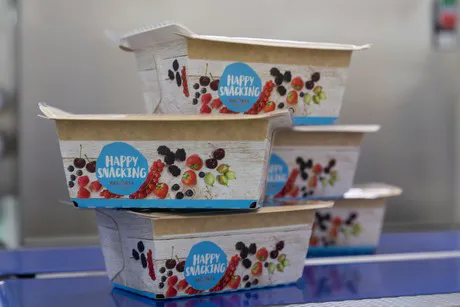 BelOrta launched new snack line to respond to increasing demand for healthy products for snacking between meals and on-the-go
BelOrta launched new snack line to respond to increasing demand for healthy products for snacking between meals and on-the-go
Start of cherry season
The cherry season has now started for BelOrta. “For a few seasons now, we’ve offered a box specifically designed for cherries. The box has a dark red colour that looks very harmonious with our cherries. This has now become a fixed value for quite a few buyers both domestically and internationally. Besides, we’ll launch a new premium box this season, for the cherries from the higher segment,” Miguel continues. BelOrta is also innovating with packaging solutions for berries. “From now on, we also offer cardboard punnets with top seal. This new packaging responds to the trend towards more sustainable packaging. The new punnets coincide with the launch of our new snack line, and this is reflected in the punnets as well. With ‘Happy Snacking’ we respond to increasing demand for healthy products for snacking between meals and on-the-go,” Miguel concludes.
Protected production
In recent years, the soft fruit area in greenhouses and tunnels has increased considerably, and this is also the case for The Greenery. “We’ve seen general outdoor production marking time,” says Business Unit Manager Soft Fruit Sjraar Hulsman. “That makes sense in a way, look at the production in, for instance, Spain, where soft fruit is mostly grown in tunnels when the weather’s warmer. It works both ways, on the one hand, you can protect the crop from the weather, so that we can arrive on the market earlier. On the other, the labour factor also plays its part, because workers are more willing to pick in tunnels than out in open fields when the weather’s bad. Besides, some regions don’t get approval to place benches due to zoning plans, and the growers there increasingly choose to produce in soil in tunnels. When benches are allowed, the choice is bench production more often, although cost price is a bit higher in that case.”
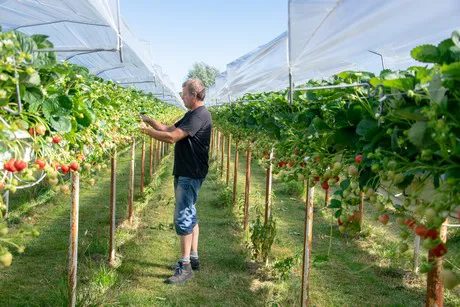 The soft fruit area in greenhouses and tunnels has increased considerably in recent years
The soft fruit area in greenhouses and tunnels has increased considerably in recent years
Changeable greenhouse strawberry season
“The greenhouse strawberry season was fairly changeable this year, the lowest point being around Easter. The market recovered after that. However, we’re seeing differences in results among the various companies, due to the share of crooked / Class II fruits. This share is particularly higher for Elsanta than growers predicted at the start of the season,” Sjraar says. The Greenery works with exclusive varieties under licences to develop the best varieties for strawberries, raspberries and blackberries, with an emphasis on flavour, shelf life and return. “For example, with strawberry variety Arabella from Plant Science we have a variety that stands out for growers regarding flavour and return. With raspberry variety Lagorai from Sant Orsola we have the best raspberry available production-wise and regarding flavour and shelf life. Besides, Lagorai has a short harvest of about three weeks and is easily harvested, so that growers can achieve a high number of kilograms per picking hour. That also makes it interesting labour-wise, while the variety is also well-received by both customers and consumers.”
The first blueberries from Dutch greenhouses were picked some weeks ago. The outdoor season starts from week 25/26. “The area has grown considerably, but so has consumption. We expect the Dutch product to find its way to the market well. Although others choose import during this period, we’ve always chosen Dutch product. Fortunately, there was no frost damage. After years of explosive growth, the Spanish season experienced a few very bad weeks this year. There were even some actions of 500 grammes of Spanish berries for €2.49. It should be clear that growers can’t produce for these prices,” Sjraar says.
Opportunities for cross-selling redcurrant?
“The redcurrant season has now started as well. Now – mid-June – redcurrants are harvested from tunnels, and from week 25 the outdoor season starts as well. For redcurrants, it’s subsequently always an estimate how much volume is placed in cold stores for long-time storage and how much volume is immediately sold. However, we have noticed that redcurrants, the only available summer fruit in the past, doesn’t show the consumption increase experienced by, for instance, blueberries and raspberries. That’s why we’re also looking for ways to increase consumption of this fruit. There are plenty of opportunities for that in our opinion. The redcurrant is sourer from itself, but combining them with something sweet, like ice cream, provides great opportunities to apply cross-selling in shops.”
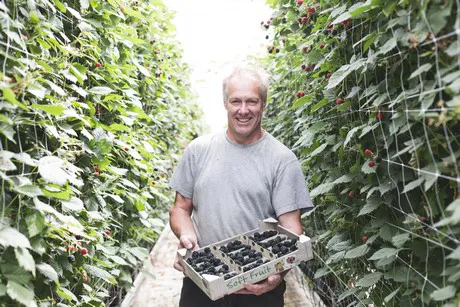
The area of greenhouse blackberries has also increase considerably in the Netherlands
Last but not least, the area of greenhouse blackberries has also increase considerably in the Netherlands, and that’s the case for The Greenery as well. “The outdoor season still has to get started. Unfortunately, the greenhouse season has been fairly difficult, except for the programmes. Large volumes are available, and pricing hasn’t been good in recent weeks. Besides, blackberries are a product that’s a bit less sensitive to promotions. Raspberry sales quintuple when promoted, but blackberry sales only triple. A lot of consumers still really have to learn to eat blackberries. With flavourful varieties that we’ll grow under licence, we’re hoping to create an important condition to that end,” Sjraar concludes.
 Miguel Demaeght
Miguel Demaeght
miguel.demaeght@belorta.be
BelOrta
Mechelsesteenweg 120
2860 Sint-Katelijne-Waver
+32 (0)15 56 56 17
verkoop@belorta.be
www.belorta.be
 Sjraar Hulsman
Sjraar Hulsman
The Greenery
Tel: +31 (0) 180 656 979
s.hulsman@thegreenery.com
www.thegreenery.com
